Business Research: Mobile Banking and Customer Retention
VerifiedAdded on 2021/05/31
|17
|4149
|123
Report
AI Summary
This report, a Business Research assignment, investigates the impact of mobile banking on customer retention and overall business performance within the banking sector. It outlines the research questions and hypotheses, exploring the relationship between mobile banking services, customer satisfaction, and the growth of the banking sector. The research employs a mixed-methods approach, incorporating both qualitative and quantitative methodologies. The qualitative component utilizes a case study design focusing on the Commonwealth Bank in Australia, employing purposive sampling to interview bank managers and collect data through structured interviews and secondary data analysis of annual reports. The quantitative aspect involves a correlational case study design. The report details the data collection, analysis, and interpretation processes, including thematic analysis for qualitative data and statistical analysis for quantitative data, aiming to assess the influence of mobile banking on customer satisfaction, retention, and the bank's business performance. The study considers the efficiency of mobile banking as an independent variable and customer satisfaction and business performance as dependent variables.
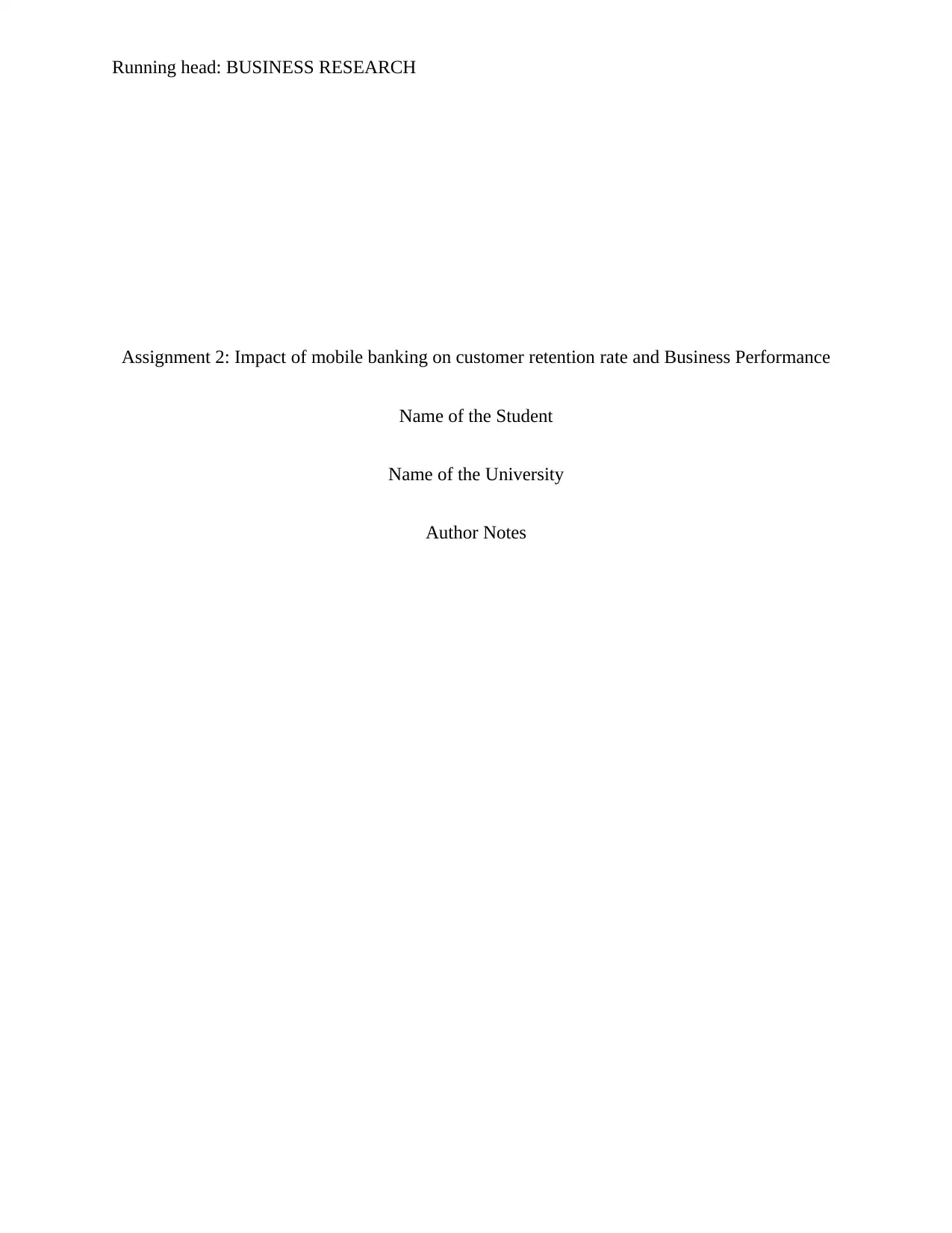
Running head: BUSINESS RESEARCH
Assignment 2: Impact of mobile banking on customer retention rate and Business Performance
Name of the Student
Name of the University
Author Notes
Assignment 2: Impact of mobile banking on customer retention rate and Business Performance
Name of the Student
Name of the University
Author Notes
Paraphrase This Document
Need a fresh take? Get an instant paraphrase of this document with our AI Paraphraser
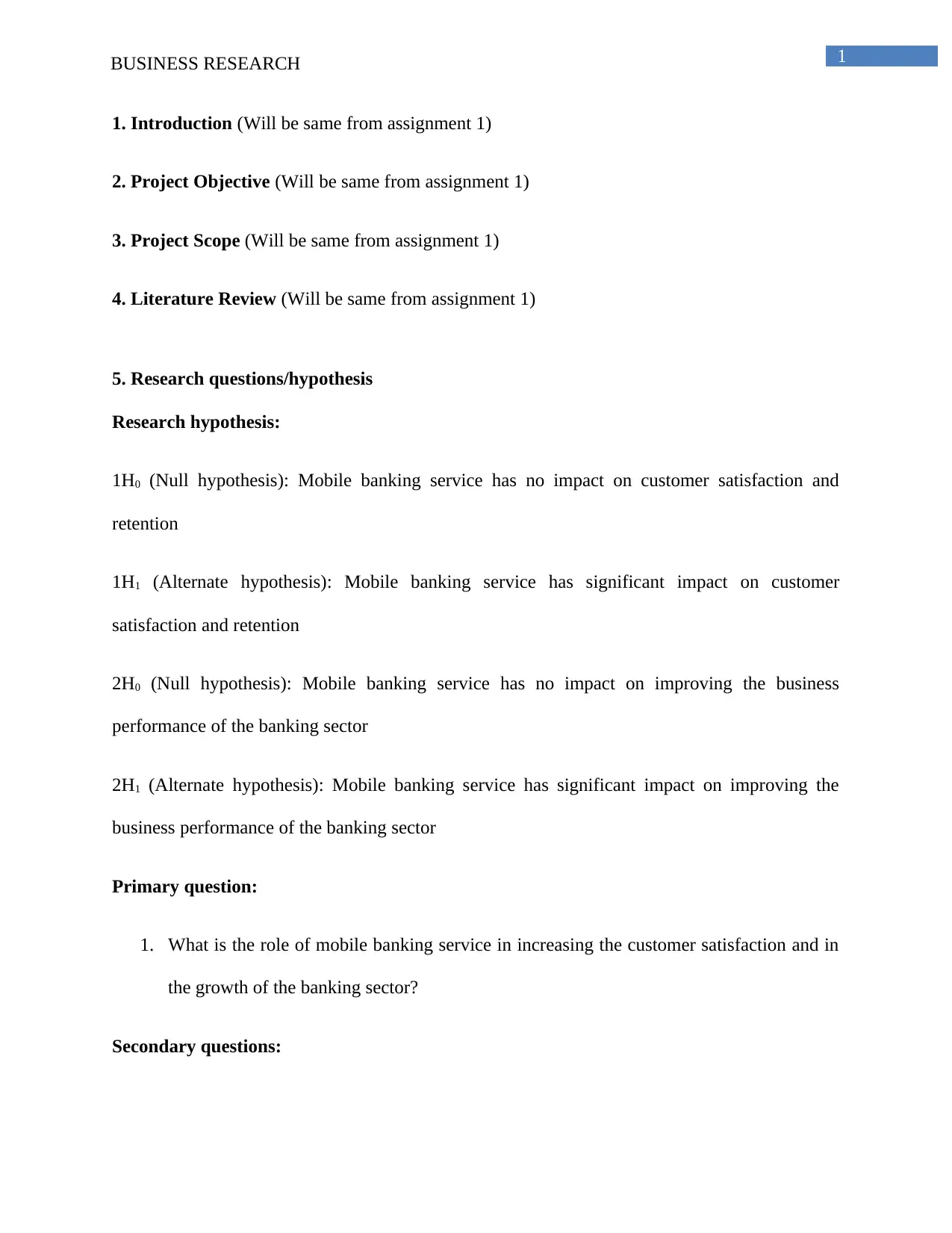
1BUSINESS RESEARCH
1. Introduction (Will be same from assignment 1)
2. Project Objective (Will be same from assignment 1)
3. Project Scope (Will be same from assignment 1)
4. Literature Review (Will be same from assignment 1)
5. Research questions/hypothesis
Research hypothesis:
1H0 (Null hypothesis): Mobile banking service has no impact on customer satisfaction and
retention
1H1 (Alternate hypothesis): Mobile banking service has significant impact on customer
satisfaction and retention
2H0 (Null hypothesis): Mobile banking service has no impact on improving the business
performance of the banking sector
2H1 (Alternate hypothesis): Mobile banking service has significant impact on improving the
business performance of the banking sector
Primary question:
1. What is the role of mobile banking service in increasing the customer satisfaction and in
the growth of the banking sector?
Secondary questions:
1. Introduction (Will be same from assignment 1)
2. Project Objective (Will be same from assignment 1)
3. Project Scope (Will be same from assignment 1)
4. Literature Review (Will be same from assignment 1)
5. Research questions/hypothesis
Research hypothesis:
1H0 (Null hypothesis): Mobile banking service has no impact on customer satisfaction and
retention
1H1 (Alternate hypothesis): Mobile banking service has significant impact on customer
satisfaction and retention
2H0 (Null hypothesis): Mobile banking service has no impact on improving the business
performance of the banking sector
2H1 (Alternate hypothesis): Mobile banking service has significant impact on improving the
business performance of the banking sector
Primary question:
1. What is the role of mobile banking service in increasing the customer satisfaction and in
the growth of the banking sector?
Secondary questions:

2BUSINESS RESEARCH
1. What are the impacts of mobile banking service on the customer satisfaction from the
banking services?
2. How does the mobile banking service improve the level of business performance of the
banking sector and contributes in its growth?
3. What are the risks associated with high usage mobile banking services that can lead to
customer dissatisfaction?
6. Research design and methodology
As mentioned earlier in the literature review, mobile banking service goes back a long
way, even before the invention of smartphone. With the advancement of technology, the nature
of mobile banking have changed and become more convenient and user-friendly. Over the years,
mobile banking services have changed the banking service scenario all over the world. The
purpose of the given research is to evaluate different features of mobile banking services and its
impact on the customer satisfaction as well as retention and on the growth of the banking sector.
Research methodology describes the strategies or actions to be taken by the researcher to
conduct the study in the most rational, comprehensive and appropriate manner to answer the
research questions unambiguously. It is composed of the process of data collection and analysis.
On the basis of the nature of the sources of the data and type of analysis process, the most
appropriate research methodology is chosen (Mackey & Gass, 2015). In the following research,
both the quantitative and qualitative facets of the research topic need to be addressed.
Qualitative research process
1. What are the impacts of mobile banking service on the customer satisfaction from the
banking services?
2. How does the mobile banking service improve the level of business performance of the
banking sector and contributes in its growth?
3. What are the risks associated with high usage mobile banking services that can lead to
customer dissatisfaction?
6. Research design and methodology
As mentioned earlier in the literature review, mobile banking service goes back a long
way, even before the invention of smartphone. With the advancement of technology, the nature
of mobile banking have changed and become more convenient and user-friendly. Over the years,
mobile banking services have changed the banking service scenario all over the world. The
purpose of the given research is to evaluate different features of mobile banking services and its
impact on the customer satisfaction as well as retention and on the growth of the banking sector.
Research methodology describes the strategies or actions to be taken by the researcher to
conduct the study in the most rational, comprehensive and appropriate manner to answer the
research questions unambiguously. It is composed of the process of data collection and analysis.
On the basis of the nature of the sources of the data and type of analysis process, the most
appropriate research methodology is chosen (Mackey & Gass, 2015). In the following research,
both the quantitative and qualitative facets of the research topic need to be addressed.
Qualitative research process
⊘ This is a preview!⊘
Do you want full access?
Subscribe today to unlock all pages.

Trusted by 1+ million students worldwide

3BUSINESS RESEARCH
Qualitative research process contains subjective, informal and semi systematic research
that puts importance on the words and human aspects rather than on the numbers collected
through the process of data collection. This is inductive in nature, in which a new phenomenon is
explored or new inferences are generated from the data. The ideologies of qualitative research
process are to collect the views of the participants to generate new theories, which are not
generalized in nature (Silverman, 2016). The characteristics of this research process are to
understand the procedures of social life and humanitarian aspects, along with an emphasis on the
background, and to put flexibility in the way of observation, research and analysis process.
The main stages of the qualitative research methods are as follows:
1. Determination of research questions
2. Design of the study
3. Collection of data
4. Data analysis and interpretation
5. Validation of the collected data
6. Report and presentation
The stages are described below.
Determination of research questions is the first and foremost section for any type of
research. Research questions help in determining the direction of the total study, the vision and
thought process of the researcher. These questions are framed in way so that they can represent
the topic of the study in the most specified and comprehensive manner (Merriam & Tisdell,
2015). In the following research study, the impact of mobile banking service on the business
performance and growth of the banking sector and on the level of customer satisfaction and
Qualitative research process contains subjective, informal and semi systematic research
that puts importance on the words and human aspects rather than on the numbers collected
through the process of data collection. This is inductive in nature, in which a new phenomenon is
explored or new inferences are generated from the data. The ideologies of qualitative research
process are to collect the views of the participants to generate new theories, which are not
generalized in nature (Silverman, 2016). The characteristics of this research process are to
understand the procedures of social life and humanitarian aspects, along with an emphasis on the
background, and to put flexibility in the way of observation, research and analysis process.
The main stages of the qualitative research methods are as follows:
1. Determination of research questions
2. Design of the study
3. Collection of data
4. Data analysis and interpretation
5. Validation of the collected data
6. Report and presentation
The stages are described below.
Determination of research questions is the first and foremost section for any type of
research. Research questions help in determining the direction of the total study, the vision and
thought process of the researcher. These questions are framed in way so that they can represent
the topic of the study in the most specified and comprehensive manner (Merriam & Tisdell,
2015). In the following research study, the impact of mobile banking service on the business
performance and growth of the banking sector and on the level of customer satisfaction and
Paraphrase This Document
Need a fresh take? Get an instant paraphrase of this document with our AI Paraphraser
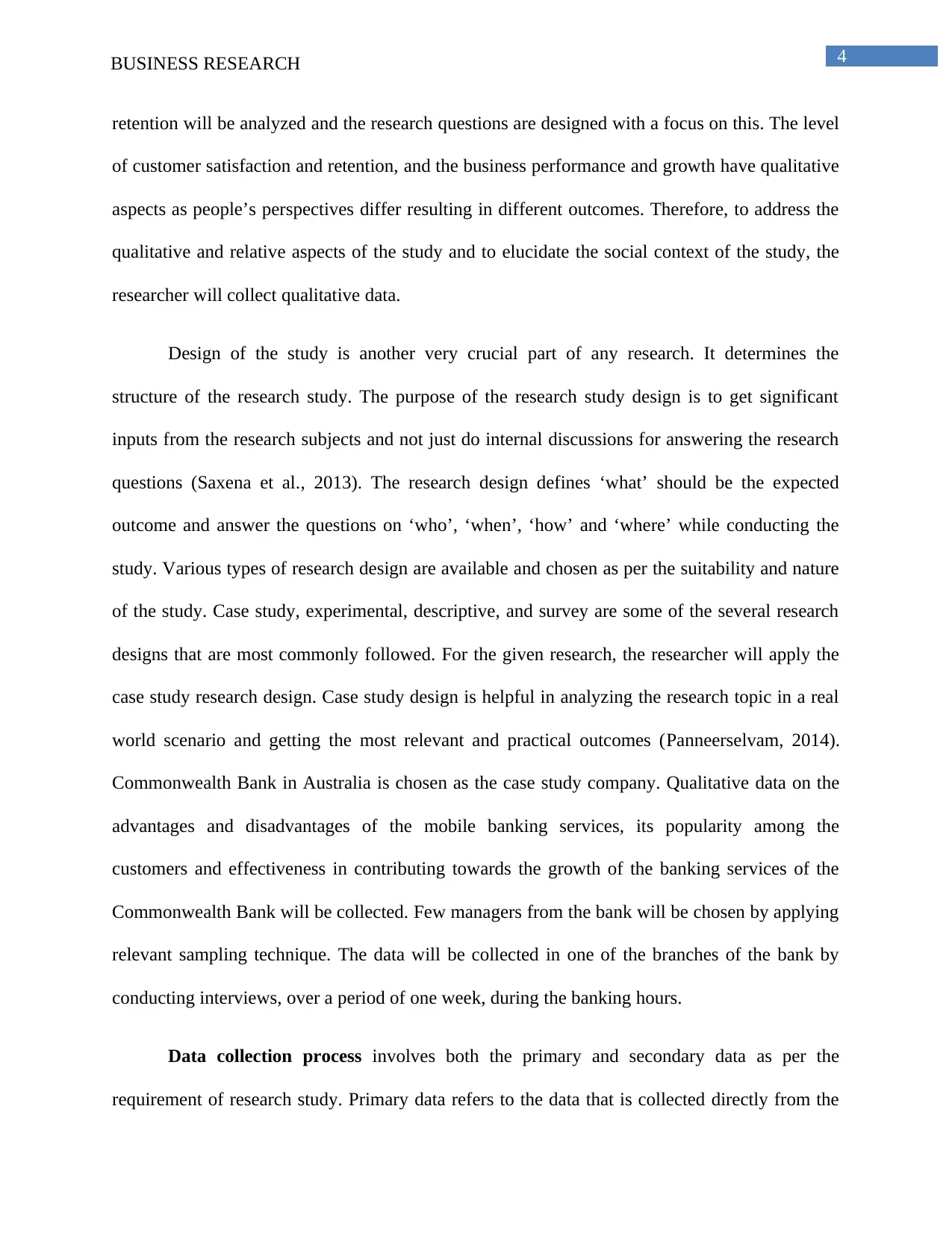
4BUSINESS RESEARCH
retention will be analyzed and the research questions are designed with a focus on this. The level
of customer satisfaction and retention, and the business performance and growth have qualitative
aspects as people’s perspectives differ resulting in different outcomes. Therefore, to address the
qualitative and relative aspects of the study and to elucidate the social context of the study, the
researcher will collect qualitative data.
Design of the study is another very crucial part of any research. It determines the
structure of the research study. The purpose of the research study design is to get significant
inputs from the research subjects and not just do internal discussions for answering the research
questions (Saxena et al., 2013). The research design defines ‘what’ should be the expected
outcome and answer the questions on ‘who’, ‘when’, ‘how’ and ‘where’ while conducting the
study. Various types of research design are available and chosen as per the suitability and nature
of the study. Case study, experimental, descriptive, and survey are some of the several research
designs that are most commonly followed. For the given research, the researcher will apply the
case study research design. Case study design is helpful in analyzing the research topic in a real
world scenario and getting the most relevant and practical outcomes (Panneerselvam, 2014).
Commonwealth Bank in Australia is chosen as the case study company. Qualitative data on the
advantages and disadvantages of the mobile banking services, its popularity among the
customers and effectiveness in contributing towards the growth of the banking services of the
Commonwealth Bank will be collected. Few managers from the bank will be chosen by applying
relevant sampling technique. The data will be collected in one of the branches of the bank by
conducting interviews, over a period of one week, during the banking hours.
Data collection process involves both the primary and secondary data as per the
requirement of research study. Primary data refers to the data that is collected directly from the
retention will be analyzed and the research questions are designed with a focus on this. The level
of customer satisfaction and retention, and the business performance and growth have qualitative
aspects as people’s perspectives differ resulting in different outcomes. Therefore, to address the
qualitative and relative aspects of the study and to elucidate the social context of the study, the
researcher will collect qualitative data.
Design of the study is another very crucial part of any research. It determines the
structure of the research study. The purpose of the research study design is to get significant
inputs from the research subjects and not just do internal discussions for answering the research
questions (Saxena et al., 2013). The research design defines ‘what’ should be the expected
outcome and answer the questions on ‘who’, ‘when’, ‘how’ and ‘where’ while conducting the
study. Various types of research design are available and chosen as per the suitability and nature
of the study. Case study, experimental, descriptive, and survey are some of the several research
designs that are most commonly followed. For the given research, the researcher will apply the
case study research design. Case study design is helpful in analyzing the research topic in a real
world scenario and getting the most relevant and practical outcomes (Panneerselvam, 2014).
Commonwealth Bank in Australia is chosen as the case study company. Qualitative data on the
advantages and disadvantages of the mobile banking services, its popularity among the
customers and effectiveness in contributing towards the growth of the banking services of the
Commonwealth Bank will be collected. Few managers from the bank will be chosen by applying
relevant sampling technique. The data will be collected in one of the branches of the bank by
conducting interviews, over a period of one week, during the banking hours.
Data collection process involves both the primary and secondary data as per the
requirement of research study. Primary data refers to the data that is collected directly from the

5BUSINESS RESEARCH
field of research, and secondary data refers to the one, which is collected from various authentic
published sources, such as, official website of government and various companies, books,
journals, newspaper articles, annual reports etc. (Lewis, 2015). The data collection process starts
with sampling. A sample is a subset of a large population having the same characteristics.
Sampling is done as studying the entire population is not possible, especially if the population is
large. Sampling techniques are of two types, namely, probability sampling and non-probability
sampling. In qualitative research process, non-probability sampling technique is most commonly
used. This type of sampling is based on the subjective judgment of the researcher and not on the
random selection (Billig & Waterman, 2013). The techniques of most common non-probability
sampling are convenience sampling, purposive sampling, quota sampling, and snowball
sampling. For this study, the researcher will apply purposive sampling technique to choose 3
managers in one of the branches of the Commonwealth Bank.
There are four types of primary data collection process under qualitative study, namely,
interview, document analysis, focus group and unstructured analysis (Maxwell, 2012). For the
given research, the researcher will conduct one on one interview process on the 3 managers of
the bank. This is beneficial to get the perspectives and insights about the different aspects and
impacts of the mobile banking services, operated by the Commonwealth Bank. The researcher
will follow structured interview method to make the analysis process easier.
Secondary data will be collected from annual reports of the company. Data will be
collected on the growth and changes in the customer base availing the mobile banking service
and revenue earned from it in the last 5 years. This will help in addressing the research questions.
field of research, and secondary data refers to the one, which is collected from various authentic
published sources, such as, official website of government and various companies, books,
journals, newspaper articles, annual reports etc. (Lewis, 2015). The data collection process starts
with sampling. A sample is a subset of a large population having the same characteristics.
Sampling is done as studying the entire population is not possible, especially if the population is
large. Sampling techniques are of two types, namely, probability sampling and non-probability
sampling. In qualitative research process, non-probability sampling technique is most commonly
used. This type of sampling is based on the subjective judgment of the researcher and not on the
random selection (Billig & Waterman, 2013). The techniques of most common non-probability
sampling are convenience sampling, purposive sampling, quota sampling, and snowball
sampling. For this study, the researcher will apply purposive sampling technique to choose 3
managers in one of the branches of the Commonwealth Bank.
There are four types of primary data collection process under qualitative study, namely,
interview, document analysis, focus group and unstructured analysis (Maxwell, 2012). For the
given research, the researcher will conduct one on one interview process on the 3 managers of
the bank. This is beneficial to get the perspectives and insights about the different aspects and
impacts of the mobile banking services, operated by the Commonwealth Bank. The researcher
will follow structured interview method to make the analysis process easier.
Secondary data will be collected from annual reports of the company. Data will be
collected on the growth and changes in the customer base availing the mobile banking service
and revenue earned from it in the last 5 years. This will help in addressing the research questions.
⊘ This is a preview!⊘
Do you want full access?
Subscribe today to unlock all pages.

Trusted by 1+ million students worldwide
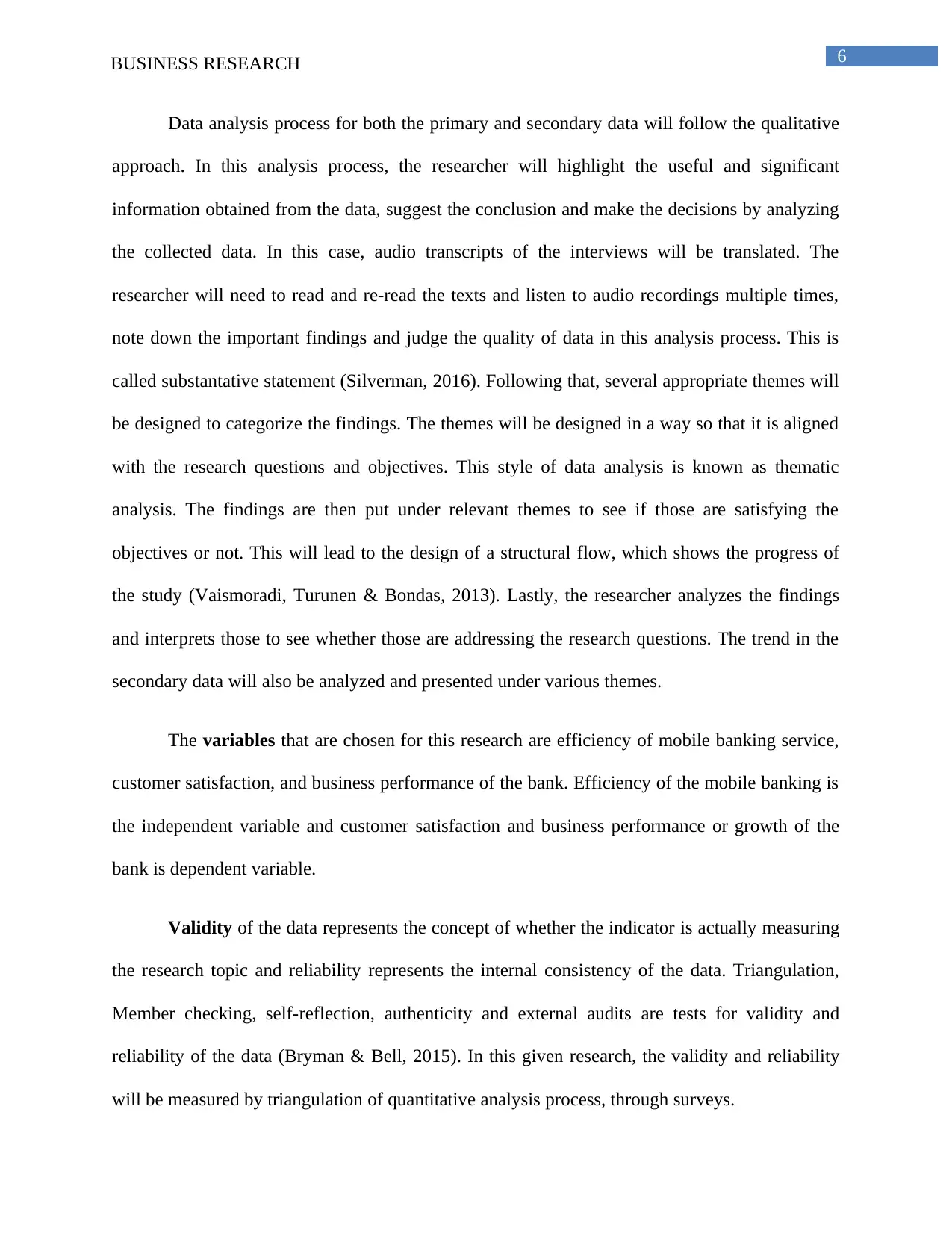
6BUSINESS RESEARCH
Data analysis process for both the primary and secondary data will follow the qualitative
approach. In this analysis process, the researcher will highlight the useful and significant
information obtained from the data, suggest the conclusion and make the decisions by analyzing
the collected data. In this case, audio transcripts of the interviews will be translated. The
researcher will need to read and re-read the texts and listen to audio recordings multiple times,
note down the important findings and judge the quality of data in this analysis process. This is
called substantative statement (Silverman, 2016). Following that, several appropriate themes will
be designed to categorize the findings. The themes will be designed in a way so that it is aligned
with the research questions and objectives. This style of data analysis is known as thematic
analysis. The findings are then put under relevant themes to see if those are satisfying the
objectives or not. This will lead to the design of a structural flow, which shows the progress of
the study (Vaismoradi, Turunen & Bondas, 2013). Lastly, the researcher analyzes the findings
and interprets those to see whether those are addressing the research questions. The trend in the
secondary data will also be analyzed and presented under various themes.
The variables that are chosen for this research are efficiency of mobile banking service,
customer satisfaction, and business performance of the bank. Efficiency of the mobile banking is
the independent variable and customer satisfaction and business performance or growth of the
bank is dependent variable.
Validity of the data represents the concept of whether the indicator is actually measuring
the research topic and reliability represents the internal consistency of the data. Triangulation,
Member checking, self-reflection, authenticity and external audits are tests for validity and
reliability of the data (Bryman & Bell, 2015). In this given research, the validity and reliability
will be measured by triangulation of quantitative analysis process, through surveys.
Data analysis process for both the primary and secondary data will follow the qualitative
approach. In this analysis process, the researcher will highlight the useful and significant
information obtained from the data, suggest the conclusion and make the decisions by analyzing
the collected data. In this case, audio transcripts of the interviews will be translated. The
researcher will need to read and re-read the texts and listen to audio recordings multiple times,
note down the important findings and judge the quality of data in this analysis process. This is
called substantative statement (Silverman, 2016). Following that, several appropriate themes will
be designed to categorize the findings. The themes will be designed in a way so that it is aligned
with the research questions and objectives. This style of data analysis is known as thematic
analysis. The findings are then put under relevant themes to see if those are satisfying the
objectives or not. This will lead to the design of a structural flow, which shows the progress of
the study (Vaismoradi, Turunen & Bondas, 2013). Lastly, the researcher analyzes the findings
and interprets those to see whether those are addressing the research questions. The trend in the
secondary data will also be analyzed and presented under various themes.
The variables that are chosen for this research are efficiency of mobile banking service,
customer satisfaction, and business performance of the bank. Efficiency of the mobile banking is
the independent variable and customer satisfaction and business performance or growth of the
bank is dependent variable.
Validity of the data represents the concept of whether the indicator is actually measuring
the research topic and reliability represents the internal consistency of the data. Triangulation,
Member checking, self-reflection, authenticity and external audits are tests for validity and
reliability of the data (Bryman & Bell, 2015). In this given research, the validity and reliability
will be measured by triangulation of quantitative analysis process, through surveys.
Paraphrase This Document
Need a fresh take? Get an instant paraphrase of this document with our AI Paraphraser

7BUSINESS RESEARCH
Reporting of the interpretation will be done at the end of data analysis procedure. This
will be containing the comprehensive illustration of data collection, analysis, and interpretation
of the findings.
Reporting of the interpretation will be done at the end of data analysis procedure. This
will be containing the comprehensive illustration of data collection, analysis, and interpretation
of the findings.
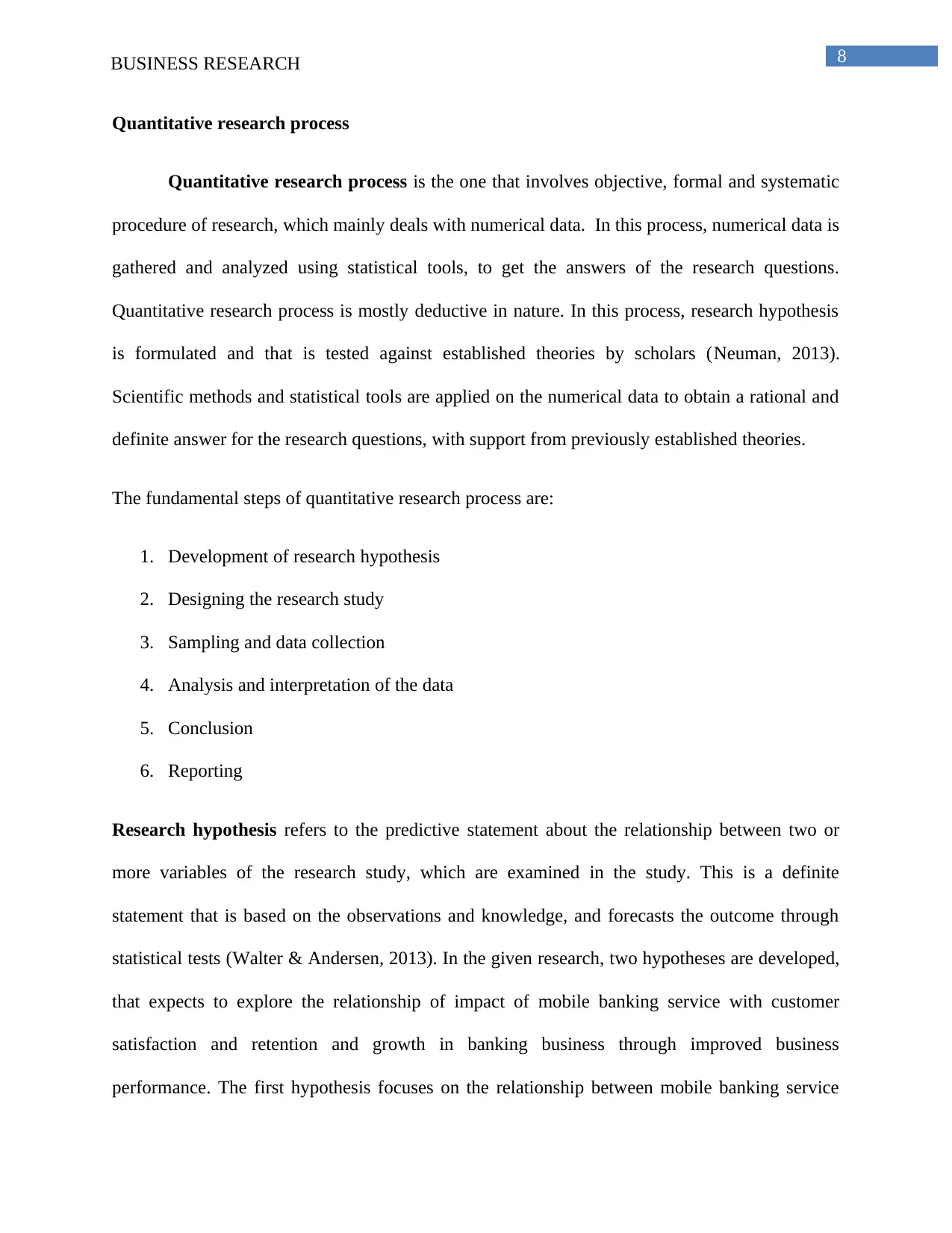
8BUSINESS RESEARCH
Quantitative research process
Quantitative research process is the one that involves objective, formal and systematic
procedure of research, which mainly deals with numerical data. In this process, numerical data is
gathered and analyzed using statistical tools, to get the answers of the research questions.
Quantitative research process is mostly deductive in nature. In this process, research hypothesis
is formulated and that is tested against established theories by scholars (Neuman, 2013).
Scientific methods and statistical tools are applied on the numerical data to obtain a rational and
definite answer for the research questions, with support from previously established theories.
The fundamental steps of quantitative research process are:
1. Development of research hypothesis
2. Designing the research study
3. Sampling and data collection
4. Analysis and interpretation of the data
5. Conclusion
6. Reporting
Research hypothesis refers to the predictive statement about the relationship between two or
more variables of the research study, which are examined in the study. This is a definite
statement that is based on the observations and knowledge, and forecasts the outcome through
statistical tests (Walter & Andersen, 2013). In the given research, two hypotheses are developed,
that expects to explore the relationship of impact of mobile banking service with customer
satisfaction and retention and growth in banking business through improved business
performance. The first hypothesis focuses on the relationship between mobile banking service
Quantitative research process
Quantitative research process is the one that involves objective, formal and systematic
procedure of research, which mainly deals with numerical data. In this process, numerical data is
gathered and analyzed using statistical tools, to get the answers of the research questions.
Quantitative research process is mostly deductive in nature. In this process, research hypothesis
is formulated and that is tested against established theories by scholars (Neuman, 2013).
Scientific methods and statistical tools are applied on the numerical data to obtain a rational and
definite answer for the research questions, with support from previously established theories.
The fundamental steps of quantitative research process are:
1. Development of research hypothesis
2. Designing the research study
3. Sampling and data collection
4. Analysis and interpretation of the data
5. Conclusion
6. Reporting
Research hypothesis refers to the predictive statement about the relationship between two or
more variables of the research study, which are examined in the study. This is a definite
statement that is based on the observations and knowledge, and forecasts the outcome through
statistical tests (Walter & Andersen, 2013). In the given research, two hypotheses are developed,
that expects to explore the relationship of impact of mobile banking service with customer
satisfaction and retention and growth in banking business through improved business
performance. The first hypothesis focuses on the relationship between mobile banking service
⊘ This is a preview!⊘
Do you want full access?
Subscribe today to unlock all pages.

Trusted by 1+ million students worldwide
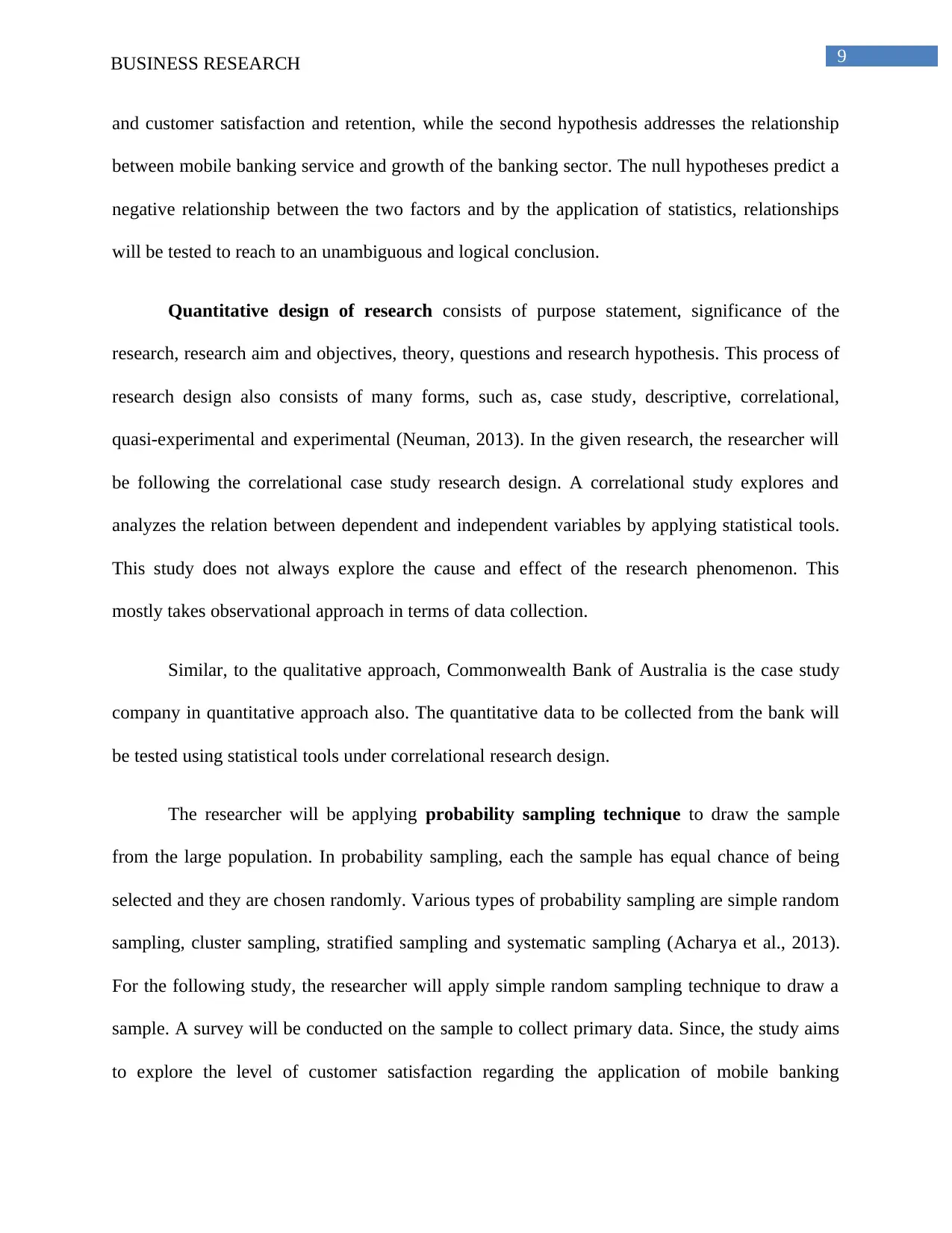
9BUSINESS RESEARCH
and customer satisfaction and retention, while the second hypothesis addresses the relationship
between mobile banking service and growth of the banking sector. The null hypotheses predict a
negative relationship between the two factors and by the application of statistics, relationships
will be tested to reach to an unambiguous and logical conclusion.
Quantitative design of research consists of purpose statement, significance of the
research, research aim and objectives, theory, questions and research hypothesis. This process of
research design also consists of many forms, such as, case study, descriptive, correlational,
quasi-experimental and experimental (Neuman, 2013). In the given research, the researcher will
be following the correlational case study research design. A correlational study explores and
analyzes the relation between dependent and independent variables by applying statistical tools.
This study does not always explore the cause and effect of the research phenomenon. This
mostly takes observational approach in terms of data collection.
Similar, to the qualitative approach, Commonwealth Bank of Australia is the case study
company in quantitative approach also. The quantitative data to be collected from the bank will
be tested using statistical tools under correlational research design.
The researcher will be applying probability sampling technique to draw the sample
from the large population. In probability sampling, each the sample has equal chance of being
selected and they are chosen randomly. Various types of probability sampling are simple random
sampling, cluster sampling, stratified sampling and systematic sampling (Acharya et al., 2013).
For the following study, the researcher will apply simple random sampling technique to draw a
sample. A survey will be conducted on the sample to collect primary data. Since, the study aims
to explore the level of customer satisfaction regarding the application of mobile banking
and customer satisfaction and retention, while the second hypothesis addresses the relationship
between mobile banking service and growth of the banking sector. The null hypotheses predict a
negative relationship between the two factors and by the application of statistics, relationships
will be tested to reach to an unambiguous and logical conclusion.
Quantitative design of research consists of purpose statement, significance of the
research, research aim and objectives, theory, questions and research hypothesis. This process of
research design also consists of many forms, such as, case study, descriptive, correlational,
quasi-experimental and experimental (Neuman, 2013). In the given research, the researcher will
be following the correlational case study research design. A correlational study explores and
analyzes the relation between dependent and independent variables by applying statistical tools.
This study does not always explore the cause and effect of the research phenomenon. This
mostly takes observational approach in terms of data collection.
Similar, to the qualitative approach, Commonwealth Bank of Australia is the case study
company in quantitative approach also. The quantitative data to be collected from the bank will
be tested using statistical tools under correlational research design.
The researcher will be applying probability sampling technique to draw the sample
from the large population. In probability sampling, each the sample has equal chance of being
selected and they are chosen randomly. Various types of probability sampling are simple random
sampling, cluster sampling, stratified sampling and systematic sampling (Acharya et al., 2013).
For the following study, the researcher will apply simple random sampling technique to draw a
sample. A survey will be conducted on the sample to collect primary data. Since, the study aims
to explore the level of customer satisfaction regarding the application of mobile banking
Paraphrase This Document
Need a fresh take? Get an instant paraphrase of this document with our AI Paraphraser

10BUSINESS RESEARCH
services, the researcher will be conducting the survey on random customers of the
Commonwealth Bank of Australia. 60 random customers will be chosen by the researcher for the
survey.
Research instruments refer to measurement devices that the researcher uses for the
purpose of the survey. The instruments are usually two types, researcher completed and subject
completed. Questionnaires, checklist, achievement or aptitude tests, attitude scales, projective
device and sociometric devices are completed by the subjects. On the other hand, rating scales,
tally sheets, flowcharts, observation forms, interview schedules, performance checklist and time
and motion logs are researcher completed instruments (Zohrabi, 2013). For the primary data
collection, research instruments are chosen based on the suitability and requirement of the
research as well as the research design. For the given research, the researcher will use survey
questionnaire and interview schedule and guide. While preparing the instruments, the researcher
will solely focus on the research topic. The survey questionnaire will contain two parts,
demographic section and the subject oriented section. Under the demographic section, the
participants will be required to answer questions on age, gender, occupation, educational
qualification, and if they are using the mobile banking service, and if yes and for how many
years. The second section will focus on gathering specific information about the mobile banking
service launched by the Commonwealth bank, its effectiveness and efficiency from the
consumers’ point of view. The questionnaire will contain close ended questions for convenience
in answering and calculating the answers. The responses will be recorded in a five point rating
scale, such as, the Likert scale, where 5 options are given for the answers, from strongly disagree
to strongly agree. These responses will be analyzed using quantitative methods. Regarding the
interview responses and secondary data on the trend in the number of users of mobile banking by
services, the researcher will be conducting the survey on random customers of the
Commonwealth Bank of Australia. 60 random customers will be chosen by the researcher for the
survey.
Research instruments refer to measurement devices that the researcher uses for the
purpose of the survey. The instruments are usually two types, researcher completed and subject
completed. Questionnaires, checklist, achievement or aptitude tests, attitude scales, projective
device and sociometric devices are completed by the subjects. On the other hand, rating scales,
tally sheets, flowcharts, observation forms, interview schedules, performance checklist and time
and motion logs are researcher completed instruments (Zohrabi, 2013). For the primary data
collection, research instruments are chosen based on the suitability and requirement of the
research as well as the research design. For the given research, the researcher will use survey
questionnaire and interview schedule and guide. While preparing the instruments, the researcher
will solely focus on the research topic. The survey questionnaire will contain two parts,
demographic section and the subject oriented section. Under the demographic section, the
participants will be required to answer questions on age, gender, occupation, educational
qualification, and if they are using the mobile banking service, and if yes and for how many
years. The second section will focus on gathering specific information about the mobile banking
service launched by the Commonwealth bank, its effectiveness and efficiency from the
consumers’ point of view. The questionnaire will contain close ended questions for convenience
in answering and calculating the answers. The responses will be recorded in a five point rating
scale, such as, the Likert scale, where 5 options are given for the answers, from strongly disagree
to strongly agree. These responses will be analyzed using quantitative methods. Regarding the
interview responses and secondary data on the trend in the number of users of mobile banking by
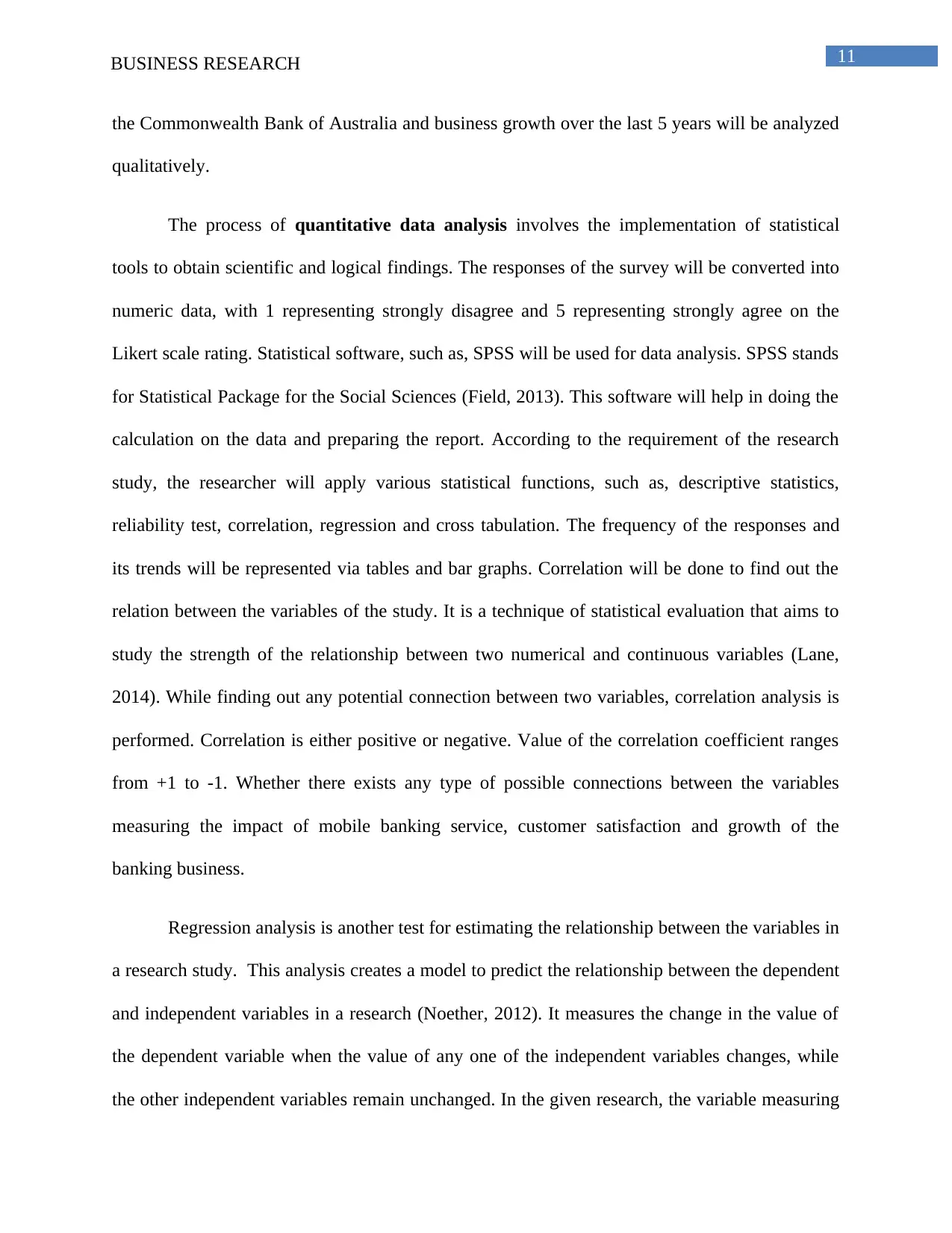
11BUSINESS RESEARCH
the Commonwealth Bank of Australia and business growth over the last 5 years will be analyzed
qualitatively.
The process of quantitative data analysis involves the implementation of statistical
tools to obtain scientific and logical findings. The responses of the survey will be converted into
numeric data, with 1 representing strongly disagree and 5 representing strongly agree on the
Likert scale rating. Statistical software, such as, SPSS will be used for data analysis. SPSS stands
for Statistical Package for the Social Sciences (Field, 2013). This software will help in doing the
calculation on the data and preparing the report. According to the requirement of the research
study, the researcher will apply various statistical functions, such as, descriptive statistics,
reliability test, correlation, regression and cross tabulation. The frequency of the responses and
its trends will be represented via tables and bar graphs. Correlation will be done to find out the
relation between the variables of the study. It is a technique of statistical evaluation that aims to
study the strength of the relationship between two numerical and continuous variables (Lane,
2014). While finding out any potential connection between two variables, correlation analysis is
performed. Correlation is either positive or negative. Value of the correlation coefficient ranges
from +1 to -1. Whether there exists any type of possible connections between the variables
measuring the impact of mobile banking service, customer satisfaction and growth of the
banking business.
Regression analysis is another test for estimating the relationship between the variables in
a research study. This analysis creates a model to predict the relationship between the dependent
and independent variables in a research (Noether, 2012). It measures the change in the value of
the dependent variable when the value of any one of the independent variables changes, while
the other independent variables remain unchanged. In the given research, the variable measuring
the Commonwealth Bank of Australia and business growth over the last 5 years will be analyzed
qualitatively.
The process of quantitative data analysis involves the implementation of statistical
tools to obtain scientific and logical findings. The responses of the survey will be converted into
numeric data, with 1 representing strongly disagree and 5 representing strongly agree on the
Likert scale rating. Statistical software, such as, SPSS will be used for data analysis. SPSS stands
for Statistical Package for the Social Sciences (Field, 2013). This software will help in doing the
calculation on the data and preparing the report. According to the requirement of the research
study, the researcher will apply various statistical functions, such as, descriptive statistics,
reliability test, correlation, regression and cross tabulation. The frequency of the responses and
its trends will be represented via tables and bar graphs. Correlation will be done to find out the
relation between the variables of the study. It is a technique of statistical evaluation that aims to
study the strength of the relationship between two numerical and continuous variables (Lane,
2014). While finding out any potential connection between two variables, correlation analysis is
performed. Correlation is either positive or negative. Value of the correlation coefficient ranges
from +1 to -1. Whether there exists any type of possible connections between the variables
measuring the impact of mobile banking service, customer satisfaction and growth of the
banking business.
Regression analysis is another test for estimating the relationship between the variables in
a research study. This analysis creates a model to predict the relationship between the dependent
and independent variables in a research (Noether, 2012). It measures the change in the value of
the dependent variable when the value of any one of the independent variables changes, while
the other independent variables remain unchanged. In the given research, the variable measuring
⊘ This is a preview!⊘
Do you want full access?
Subscribe today to unlock all pages.

Trusted by 1+ million students worldwide
1 out of 17
Related Documents
Your All-in-One AI-Powered Toolkit for Academic Success.
+13062052269
info@desklib.com
Available 24*7 on WhatsApp / Email
![[object Object]](/_next/static/media/star-bottom.7253800d.svg)
Unlock your academic potential
Copyright © 2020–2025 A2Z Services. All Rights Reserved. Developed and managed by ZUCOL.





